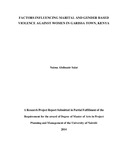| dc.description.abstract | Accurate measurement of the levels of mortality is a fundamental aspect of research in
demography; infant and under-five mortality rates need to be estimated both precisely, accurately
and should refer to as recent a time as possible. Estimates of infant and child mortality rates are
usually derived in two ways: by using the direct method and indirect method.
The general objective of this study is to estimate and compare infant and child mortality in
Kenya derived from the three variants of the Brass indirect methods; women classified by age
group, time since first birth, and duration of marriage. The analysis was based on data from the
1993, 1998, 2003 and 2008/09 Kenya Demographic and Health Surveys.
Estimates of infant and under-five mortality in Kenya using the three Brass variants were
calculated by the spreadsheet developed by the International Union for the Scientific Study of
Population under the Tools for Demographic Estimation (2013).
Graphs were generated that show trend-lines in the general direction and levels of infant and
child mortality that each variant produces. A straight average of indirect estimates illustrates the
general trend in infant and under-five mortality for the period 1993 to 2009 as depicted by the
combined indirect estimates and published direct estimates. Paired difference method was used
to test whether the differences between each pair of the three Brass variants were statistically
significant.
Evidence from this study indicates that all variants of the Brass methods produce estimates that
are at similar levels and can be relied upon to track accurate trends in infant and under-five
mortality. Further, direct and indirect estimates are comparable as the differences were proved to
be statistically insignificant. Given that the variants of the method provide similar results with
little or no disparity, the choice by users should be influenced by the simplicity and convenience
of the technique and availability of required data.
The major policy implication drawn from the study is that, despite evidence of a recent reduction
in infant and under-five mortality, achieving MDG 4 targets will be a challenge. Therefore, the
government of Kenya should accelerate efforts if it is to achieve targets set out in the post
MDG’s 2015 agenda and the National Population Policy. In addition, there is need for further
research on consistency of these estimates when data is adjusted to reflect biases introduced by
HIV/AIDS. | en_US |

